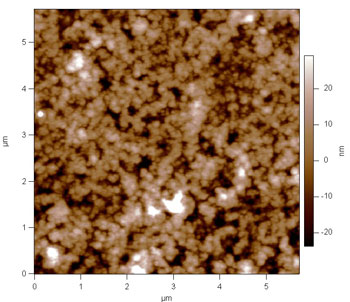| Posted: Mar 31, 2008 | |
Ivy's gripping nanotechnology secrete |
|
| (Nanowerk Spotlight) You probably have seen quite a number of research reports on the amazing climbing abilities of geckos. Here at Nanowerk, we ran several Spotlights on this topic, for instance on mimicking gecko toe structures to fabricate super-strong dry adhesives. One demonstration of so-called 'gecko tape' has already been used in building Stickybot, a quadruped robot capable of climbing smooth vertical surfaces, such as glass, acrylic and whiteboard. | |
| In addition to the animal kingdom, scientists have started looking at plants to identify biological climbing mechanisms that could be exploited for engineering applications. One obvious candidate is ivy, a climbing woody plant. Researchers now have found that ivy secretes nanoparticles which allow the plant to affix to a surface and play an important role in the plant's climbing capability. This ivy secretion mechanism may inspire new, 'green' methods for synthesizing nanoparticles biologically or new approaches to adhesion mechanisms for mechanical devices. | |
| "Charles Darwin reported in 1876 that ivy rootlet secretes yellowish matter while climbing a surface" Dr. Mingjun Zhang tells Nanowerk. "But the questions are still open for what is contained in the secreted material and how the matter is related to the ivy climbing mechanism. We have first applied optical microscopy and AFM to study morphology of the secreted materials on a substrate surface and then treated these materials to solvent extraction and to use high-performance liquid chromatography/mass spectrometry (HPLC/MS) for analyzing the nanoparticle chemical composition." | |
| Zhang, an Associate Professor of Biomedical Engineering and Director, Nano Bio-systems, Bio-instrumentation and Automation Lab at the University of Tennessee, is first author of a recent paper in Nano Letters where he, together with collaborators from the university as well as Agilent Technologies, observed that ivy secretes large numbers of nanoparticles from tendrils of the adhering disk ("Nanoparticles Secreted from Ivy Rootlets for Surface Climbing"). | |
| The most salient feature revealed through atomic force microscopy is the high degree of uniformity of the nanoparticles. The particles are about 70 nm in diameter and their average height is about 20–30 nm. | |
 |
|
| Nanoparticles secreted from fingers of the adhering disks of an ivy rootlet. (Image: Dr. Zhang) | |
| Zhang and his team found that the nanoparticles are delivered from the ivy rootlets of the stem, to the adhering disk, and finally to its fingers. "Our observations support the hypothesis that the nanoparticles play a direct and important role for ivy surface climbing and are directly related to the ivy affixing capability" he says. |  |
| In addition to a physical analysis, the scientists submitted the ivy nanoparticles to a chemical composition analysis through extract analysis by HPLC/MS. This analysis suggests empirical formulas for the 19 prevalent compounds of organic composition from the secreted nanoparticles. | |
| "These formulas indicate that most of these compounds contain oxygen, nitrogen, and sulfur" Zhang explains. "These compounds are widely known for their ability to generate polar materials and, most importantly, hydrogen bonding. Considering the surfaces that the nanoparticles normally or typically attach to are substrates like rocks, bricks, etc., which are inorganic or at least polar in nature, the composition suggests that the nanoparticles rely on hydrogen bonding to affix to different surfaces." | |
| By observing the evolution of the nanoparticles during the climbing process, the scientists noticed that a yellowish material was gradually secreted which, in the earliest stage, is in the gel state and later becomes dry. Once the secretion and drying are completed, the materials are attached firmly to the surface. It appears that water is evaporated during this process. | |
| Zhang notes that millions of adhering disks can generate remarkable adhesion for the ivy to affix to a surface. "The affixing mechanism formed by the nanoparticles and the adhering disk is unique" he says. "The ivy climbing mechanism by secreting nanoparticles has many advantages for surface climbing. First, joints are not needed and complex mechanics are avoided, yet the mechanism is flexible enough to adapt to various environments." | |
| Zhang's experiments with ivy may also inspire mechanisms for fabricating nanoparticles through plants. Considerable efforts have been made to generate nanoparticles biologically. In a previous Spotlight we showed some examples of how scientists are trying to use microorganisms and plants for the deliberate synthesis of nanomaterials (Truly green nanotechnology - growing nanomaterials in plants) – for instance the growth of gold nanoparticles in alfalfa sprouts or the biosynthesis of gold and silver nanoparticles from the Cinnamomum camphora leaf. | |
| Zhang is now looking to secure funding to develop his discovery into practical applications. Clearly, harnessing nanoparticles capable of adhesion through hydrogen-bonding mechanisms could be useful for designing new industrial and medical adhesives, similar to what researchers already have demonstrated by mimicking the gecko's climbing capabilities. | |
 By
Michael
Berger
– Michael is author of three books by the Royal Society of Chemistry:
Nano-Society: Pushing the Boundaries of Technology,
Nanotechnology: The Future is Tiny, and
Nanoengineering: The Skills and Tools Making Technology Invisible
Copyright ©
Nanowerk LLC
By
Michael
Berger
– Michael is author of three books by the Royal Society of Chemistry:
Nano-Society: Pushing the Boundaries of Technology,
Nanotechnology: The Future is Tiny, and
Nanoengineering: The Skills and Tools Making Technology Invisible
Copyright ©
Nanowerk LLC
|
|
Become a Spotlight guest author! Join our large and growing group of guest contributors. Have you just published a scientific paper or have other exciting developments to share with the nanotechnology community? Here is how to publish on nanowerk.com.
